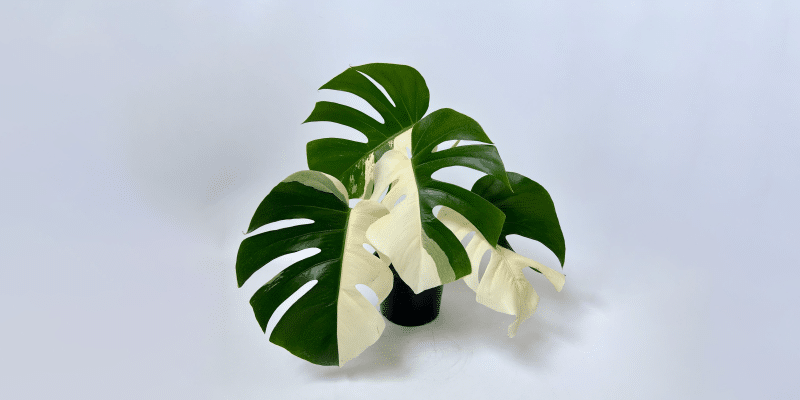Monstera Albo, are you green, are you white… make up your mind!
Are they as easy to take care of as plain old Monstera deliciosa?
Not quite.
Variegated Monsteras need more light, and and might need a bit of pruning to preserve their variegation.
We’ll teach you how to take care of your Monstera albo so it stays colorful and retains its variegation. We’ll also go into how to propagate more plants and cover the most common issues that come up.
Table of Contents
Monstera Albo Care Guide
History, habitat, and characteristics
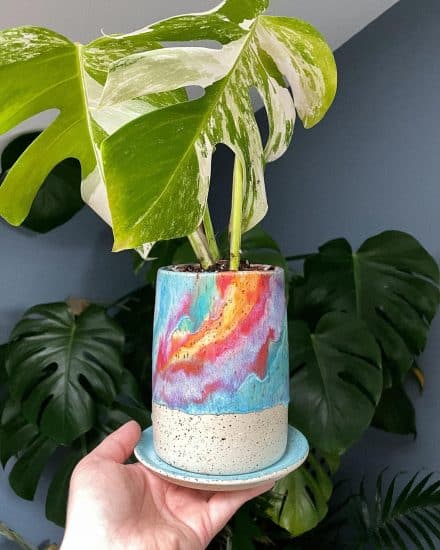
Also called Monstera deliciosa ‘Variegata,’ Monstera albo is, you guessed it, the variegated version of Monstera deliciosa. Sometimes called Monstera albo ‘Variegata’ or Monstera borsigiana albo, it’s a slow grower from the Araceae family that retains the same fenestrations (or holes) its parent is famous for. Leaves start out heart-shaped and develop the splits as they grow.
Monstera comes from the Latin word for “abnormal” or “monstrous” (referring to the fenestrations in this plant’s leaves), and deliciosa means delicious (referring to its fruit — in the wild, Monstera deliciosa can make an edible fruit with a sweet flavor).
Albo comes from the Latin albus, or white. Monstrous, delicious, and white — that’s our baby.
While its mother plant is a vine with long stems that climbs up trees in the Central American rainforest, Monstera albo doesn’t exist in the wild at all.
You see, the Monstera albo’s variegation is courtesy of a genetic mutation that causes parts of its leaves to stop producing chlorophyll (which means they can’t photosynthesize) and turn white. And a plant that can’t photosynthesize as well as its relatives in the wild?
Speaking from an evolutionary standpoint, it’s a goner.
But since humans have chosen to cultivate this plant despite, and even because of, its genetic mutation (aw, aren’t we a nice bunch?), it thrives and is considered very desirable.
This lovely plant has different types of green and white variegation that make each leaf unlike any other. There’s marbled (or mottled) versus sectoral, with large uninterrupted patches of color, and the two types can coexist.
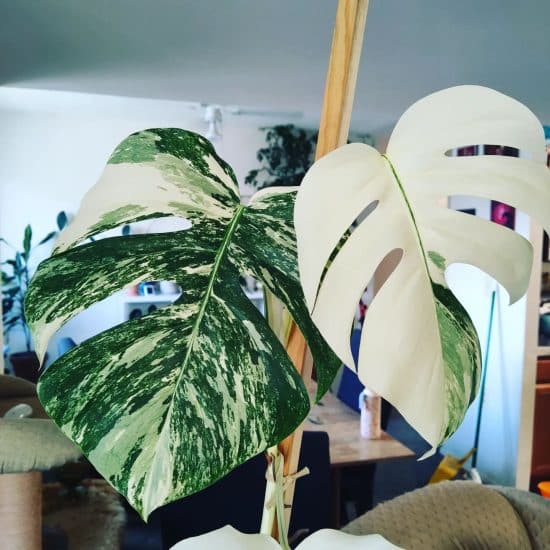
There are even coveted half-moon and full-moon (all white) leaves, although it’s best to prune these (we cover this in the Pruning section).
On to the monstrous question in the room: Do you have space for a fledgling Monstera albo in your home?
While this plant can grow 8 to 13 feet high and 3 to 5 feet wide, you won’t need to clear out an entire room for it right away. Remember: this one grows slowly — it takes anywhere from 10 to 20 years to get there.
Monstera albo’s height can be an advantage, since it grows aerial roots for support, making it a prime candidate for moss poles.
It doesn’t usually flower indoors, but mature plants can put out small, creamy-white blooms.
Variegated Monstera Deliciosa Plants
Variegated Monstera Albo is one of a few different Monstera deliciosa variants, including:
- Monstera ‘Thai Constellation’: Genetically engineered to have stable variegation that’s also less random than the Monstera albo, this one has small creamy flecks and grows much more quickly.
- Monstera ‘Aurea’: The same fenestrated leaves with gold variegation in all sorts of speckly and splotchy shapes.
- Monstera ‘Mint Variegata’: A newer variant that some people call “mint Monstera,” this plant’s leaves have an intricate lighter green and white variegation.
Light
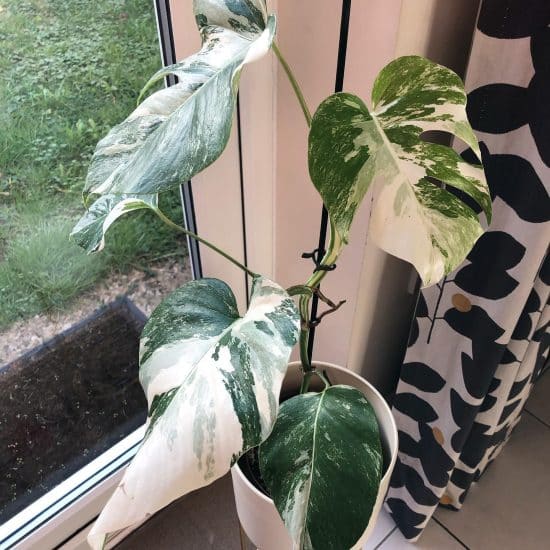
Monstera albo thrives in bright indirect light and lots of it. Variegated monstera plants like this one (and variegated plants in general) need more light from the start than their parent plants because their leaves don’t produce as much chlorophyll — all the non-green spots don’t have any.
But the catch is . . . the very leaves that require light the most (aka the whitest) are also the most easily scorched by direct sun. And that precious variegation can fade in too much direct light.
Not to worry, though — just make sure to shield your plant from direct sunlight with a sheer curtain, and try to place the whitest parts of the plant farthest from the sun, if possible.
The key to giving this plant just the right amount of light is keeping an eye on its variegation, which can disappear (as opposed to fade) if it doesn’t get enough.
Setting your Monstera close to an east-facing window or a few feet from a south or west-facing exposure (which let in more direct light) is ideal.
Regardless, wherever you put your plant, if you notice its pretty colors turning solid green due to lack of light, consider picking up an LED grow light to supplement.
Lighting Tips:
- Avoid direct sunlight, since it can sunburn leaves and cause variegation to fade
- Too little light: yellowing and curling leaves, leaves turning completely green
- Too much (direct or indirect) light: wilted, dry leaves with faded variegation
Water
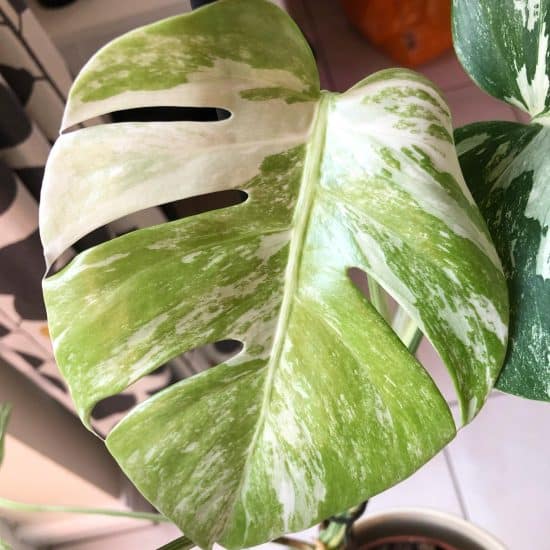
When it comes to watering your Monstera albo, consistency is key. When to water?
Whenever the soil is dry two inches down from the surface. This means more often during hot weather and less often in cold. Keep in mind that your home’s humidity and plant pot size also play a role in watering frequency.
I always give my plant a thorough watering, making sure to get the soil, moss pole, and aerial roots. The goal here is moist soil without being waterlogged.
This beauty is sensitive to salt buildup in the soil, so you may want to use filtered, distilled, or even rainwater if you can, as opposed to tap.
(Full disclosure, I use tap water and mine has been doing just fine so far.)
Tip: If you notice your plant’s leaves are starting to sweat after watering it, this means it’s getting more water than it can handle and trying to push it out. Reduce the amount of water you give it to avoid root rot.
On the other hand, leaves wilting and stem shriveling? Give this Monstera a drink!
Temperature and humidity
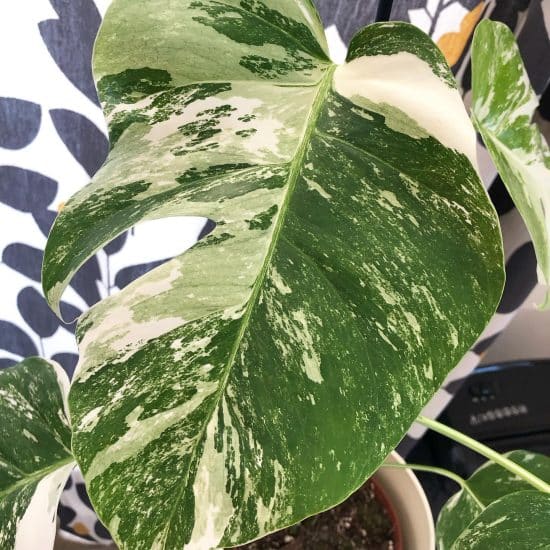
When it comes to keeping your Monstera albo happy, temperature and humidity are just as important as water.
Let’s talk temperature. This plant prefers anywhere between 65-80 degrees Fahrenheit. Normal household temps should suffice, but your plant won’t appreciate anything below 60 degrees (it does hail from the tropics, after all).
Also, these guys don’t like sudden temperature changes, so keep them away from drafty windows or vents.
Then we have humidity. Aim to keep your plant in an environment with at least 50%, although higher is better. If your home isn’t quite that humid, you can:
- Set up a pebble tray and let the evaporating water bump up the local humidity around your plant
- Put a humidifier nearby
- Cluster plants together to share humidity
While you can mist Monstera albo, this will only raise the humidity for a short period of time and is really best for preventing dust buildup and bugs. Make sure to wipe it down with a cloth after!
Soil and planting
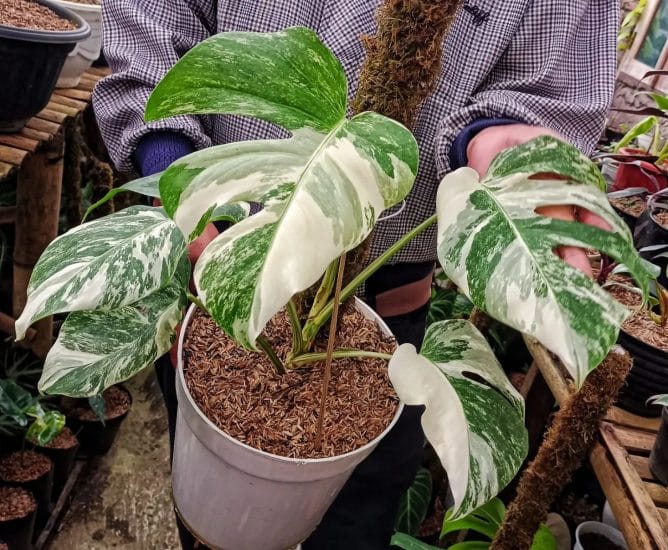
Monstera albo needs a neutral to acidic soil mix (pH between 6.0 and 7.0) that does two things: a) promotes drainage, and b) holds enough moisture for the plant to thrive.
This isn’t as contradictory as it might seem at first read, mainly because there are tons of soil ingredient combos that both retain and drain moisture.
Many types of loose potting mixes suit this plant. An example of a great mix could be:
- 50% high-quality potting soil
- 25% orchid bark (helps with drainage)
- 25% perlite (adds aeration)
As long as the medium is loose and leaves room for your plant’s roots to breathe, it will work swimmingly. In fact, I have friends who swear by LECA and pon when their Monstera wasn’t doing well in soil.
Fertilizing
Fertilize your plant once a month during the growing season (spring and summer) with a 50% diluted balanced liquid houseplant fertilizer. Don’t fertilize at all during the winter, since your plant can’t uptake the nutrients then, and they might actually cause a fair bit of harm.
Pruning
Aside from pinching off dead leaves, you don’t really need to prune this plant . . . unless one of two things happens:
Your Monstera albo produces a full moon leaf (totally white). Although full moon leaves look eerily beautiful, it’s best to prune them (after snapping the requisite photos, of course!). Since they have can’t photosynthesize (no green chlorophyll!), they’re deadweights that take up your plant’s energy without producing anything in return. They’ll die and fall off quickly anyway. It’s a bit of a bummer, but beauty is pain.
Your Monstera albo starts reverting (leaves emerge solid green). When two leaves in a row come out completely green (one leaf isn’t necessarily an issue), this might be a sign your plant is reverting, or turning back into a normal Monstera deliciosa. (Make sure the culprit isn’t poor lighting first).
If your plant gets plenty of light and you want to prevent it from reverting, snip off the newer green leaves until you’re back to the last variegated leaf. This will hopefully encourage your plant to produce more leaves with the variegation we know and love.
Repotting
Since these guys aren’t the fastest growers, they’ll only need repotting once every year or two. Pick a pot one or two sizes bigger than the previous one, and make sure it has at least one drainage hole.
Now you can care for Monstera albos, but can you make new ones? Our handy dandy propagation guide will set you on the right path.
Propagation guide
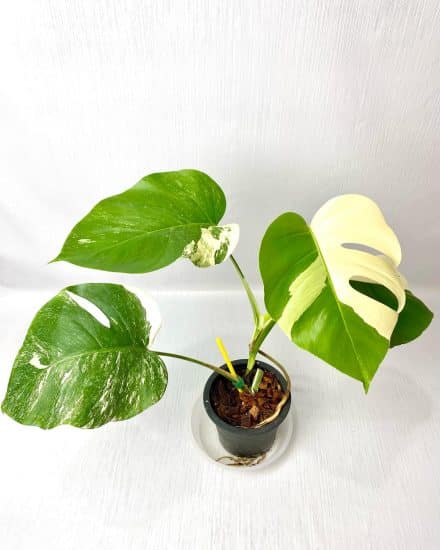
Propagating Monstera albo takes longer than plain Monstera deliciosa, but this doesn’t mean the process has to be difficult! Keep in mind, though: You can’t propagate a Monstera albo from seed.
Anyone claiming to sell Monstera albo seeds is either uninformed or unscrupulous. That’s because this plant’s variegation is genetic and can’t be passed along from a seed — you’ll just end up with a plain Monstera deliciosa.
Stem or Leaf Cuttings?
What you can do, though, is propagate it from leaf or stem cuttings (also known as wet sticks). Stem cuttings are cheaper than leaf cuttings, but require a lot of patience because you have to wait two or three months for a leaf to emerge first. They can also be prone to root rot.
You can propagate these plants in perlite, LECA, or water, but I recommend sphagnum moss. It’s my personal favorite way to propagate this plant, and one I’ve had great success with in the past. This works with either a stem or a leaf cutting.
Tip: Stem or leaf cuttings with high variegation are more likely to produce plants with high variegation, but since this is a genetic mutation we’re talking about here, nothing is guaranteed.
Propagating Monstera albo in sphagnum moss:
- Wet a few handfuls of sphagnum moss, squeeze excess moisture out, and put them in a clear container (lid optional).
- Place the cutting into the moss. With leaf cuttings, make sure the leaf is above the moss. Stem cuttings should be at least half covered, and the node, or the place where a new leaf will sprout, should be able to receive air and water (from the moist moss) at the same time.
- Optional: For stem cuttings, keep the lid on the container. You can cut holes in the lid to promote airflow, but this isn’t necessary. Stem cuttings need to be kept in as close to 80% humidity as possible.
- Remove the stem cutting from the moss and mist it at least once a day.
- Keep the cutting in bright indirect light and make sure the moss stays moist but not dripping wet. (Stem cuttings can take up to 2-3 months before producing new leaves, so be patient!).
- Next up: roots! When these are roughly 2-3 inches long, transfer the cutting to a potting mix of your choice and keep it in bright, indirect light. Moist soil and high humidity are a must for the next few weeks. After that, normal care will suffice.
And that’s all, folks — you’ve officially propagated a Monstera albo!
Common issues
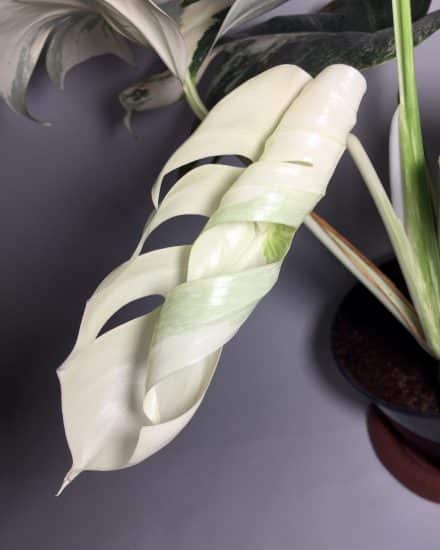
Monstera albo have the same problems as other household plants — which also means there are tried and true solutions.
Drooping Leaves
Your plant’s leaves can droop if they’re not getting enough water. If you’re sure you’re giving it enough, check the soil to make sure the plant’s roots can breathe. If its roots are waterlogged, it won’t be able to take up the water you’re giving it. This is yet another great time to emphasize the importance of plant pot drainage holes.
Brown Leaves
Brown spots or burn marks on the leaves of your Monstera albo are usually a sign of too much direct sunlight. If you see these signs, move your plant a few feet away from the light source or diffuse it with a sheer curtain.
Overall leaf browning paired with crispy edges can mean your plant needs more water. Water right when the soil two inches down gets dry — you don’t want to dehydrate your baby!
Yellow Leaves
While some yellow leaves on your Monstera albo are natural, especially if they’re older, if all of the leaves on your plant are yellowing, this could be a sign of overwatering. Make sure you’re allowing the soil to dry out between waterings to give your plant a bit of breathing room.
Lack of Variegation
If established leaves on your plant start to lose their variegation and become all green, it’s not getting enough light. Move your plant three to five feet away from the light source, or diffuse it with sheer fabric or other plants.
If new leaves are coming out green, however, your plant might be reverting. It’s best to prune these off to the last variegated leaf to encourage more variegation.
Diseases and pests
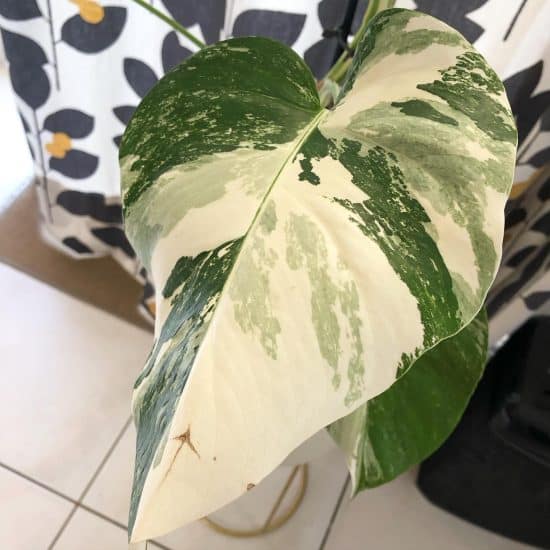
Root rot, fungus, and bugs: the age-old scourge of the plant world. You can defeat them with equally time-tested methods and help keep your Monstera healthy and happy.
Root Rot
Like most plants, Monstera albo don’t like to sit in excess water, which can cause . . . dum, dum, dum . . . root rot. Signs to look out for include yellowing, wilting leaves with brown spots, combined with black, slimy roots.
Solution: First cut off any infected roots (those mushy ones). Repot your plant in fresh soil and let the mix thoroughly dry out between waterings.
Fungus
Powdery mildew or fungal leaf spot can both affect Monstera albo. Powdery mildew takes the form of a white powdery coating or white spots on leaves, while fungal leaf spot causes parts of the leaf to die and turn brown or black.
Cut off any affected leaves with scissors or shears, sterilizing them before and after. If you want to take a less chemical route first, spray your Monstera with a baking soda and water combo (1 teaspoon of baking soda per quart of water). If this doesn’t help curtail the fungus, it’s time to use a fungicide. Follow the instructions on its label.
Pests
Mealybugs, fungus gnats, and spider mites are attracted to Monstera albo plants. These pests appear as small white bugs or webbing on the underside of leaves and around the stems.
If you notice any bugs, isolate the plant so the problem doesn’t spread. Treat your plant with diluted neem oil right away and reapply in two weeks. You can also lightly spray water on both sides of its leaves to flush out any hidden bugs.
Conclusion
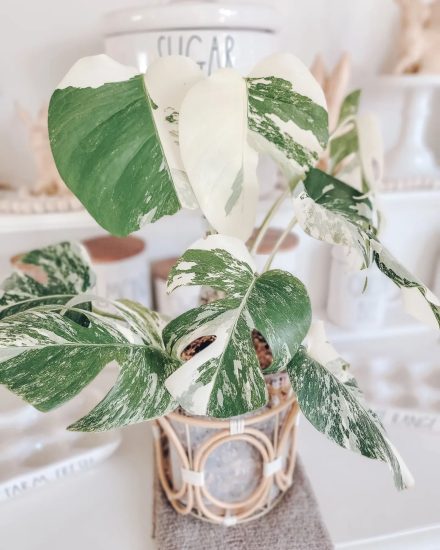
Monstera albo is definitely the “it” plant right now. Once a rare plant but becoming less so with every stem or leaf cutting . . . Who knew a genetic mutation could spark such obsession?
And while it’s a slower grower than Monstera deliciosa, it’s so worth the effort!
Were you lucky enough to snag your very own Monstera albo? Tell us all about it! And please . . . send pictures (and cuttings? Just kidding! Maybe).
FAQ
Why are Monstera albo expensive?
These beauties grow slowly because their variegation means they have less chlorophyll . . . which prevents them from photosynthesizing as quickly as regular Monstera. Combine this plant’s super popularity with the time and effort it takes to grow, and you’ve got the ultimate recipe for a pricey Monstera!
How much should a Monstera albo cost?
This will range according to where you live, as well as the size of the plant and its level of variegation. In general, as of the time of this writing, full plants can sell for as much as $700 to $5,000 each. Not exactly lunch money!
Is Monstera albo easy to care for?
Fairly! Just keep that humidity up as close to 60% or 70% as possible, and watch out for fading variegation or all green leaves. We cover what to do if those things happen to your plant in the “Common Issues” section!

